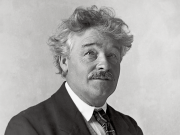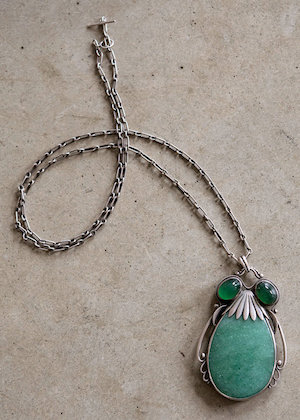Case Study: Georg Jensen
Meet Georg Jensen

 Georg Jensen silver is a favorite among those drawn to the sleek and timeless pull of Scandinavian design. Georg Jensen began his career with apprenticeships in goldsmithing and sculpting. Following their completion, Jensen translated these fine skills into silver, establishing his silver smithy in Copenhagen in 1904. Influenced by the rural surroundings of his childhood home in Raadvad, Denmark, many of his designs were based on elements of the natural world, including fruit, flower blossoms, leaves and other organic forms. Infusing the intricacies of goldsmithing with the artistry of sculpting, Jensen created one-of-a-kind, era-defining jewelry, holloware and flatware patterns that rejected popular, ostentatious designs in favor of avant-garde Art Nouveau and, later, streamlined modernism. Jensen’s aim was to create beautiful, everyday wares that would be affordable to the masses and, by the time of his death in 1935, his work was known world-wide for pushing the boundaries of traditional silversmith design.
Georg Jensen silver is a favorite among those drawn to the sleek and timeless pull of Scandinavian design. Georg Jensen began his career with apprenticeships in goldsmithing and sculpting. Following their completion, Jensen translated these fine skills into silver, establishing his silver smithy in Copenhagen in 1904. Influenced by the rural surroundings of his childhood home in Raadvad, Denmark, many of his designs were based on elements of the natural world, including fruit, flower blossoms, leaves and other organic forms. Infusing the intricacies of goldsmithing with the artistry of sculpting, Jensen created one-of-a-kind, era-defining jewelry, holloware and flatware patterns that rejected popular, ostentatious designs in favor of avant-garde Art Nouveau and, later, streamlined modernism. Jensen’s aim was to create beautiful, everyday wares that would be affordable to the masses and, by the time of his death in 1935, his work was known world-wide for pushing the boundaries of traditional silversmith design.
Collaboration
Georg Jensen recognized the value of inviting other artistic perspectives into his work, collaborating with a number of exceptionally talented silversmiths, metalworkers, jewelers, designers and artists throughout his career. This tradition lives on today as it maintains the company’s position at the forefront of modern design. Some notable collaborators have included designer Henning Koppel, furniture designer Arne Jacobsen and architect Zaha Hadid.
Jewelry
 Much like his flatware and tabletop pieces, early jewelry examples by Georg Jensen were crafted in stylized botanical forms. The hand-hammered sterling silver pieces were often bezel-set with semi-precious stones, such as carnelian, moonstone, amber and amethyst. His designs were greatly appreciated even at his business’s infancy, as the Danish Museum of Decorative Art purchased some of his first pieces in 1904. His work was also a favorite among members of the Danish court and the wealthy merchant class. Following WWII, his jewelry designs began streamlining, thanks in part to designers Henning Koppel and Vivianna Torun Bülow-Hübe in his smithy. Today, the company continues to design jewelry in the sleek, streamlined manner that is now considered synonymous with the brand.
Much like his flatware and tabletop pieces, early jewelry examples by Georg Jensen were crafted in stylized botanical forms. The hand-hammered sterling silver pieces were often bezel-set with semi-precious stones, such as carnelian, moonstone, amber and amethyst. His designs were greatly appreciated even at his business’s infancy, as the Danish Museum of Decorative Art purchased some of his first pieces in 1904. His work was also a favorite among members of the Danish court and the wealthy merchant class. Following WWII, his jewelry designs began streamlining, thanks in part to designers Henning Koppel and Vivianna Torun Bülow-Hübe in his smithy. Today, the company continues to design jewelry in the sleek, streamlined manner that is now considered synonymous with the brand.
Flatware
 In 1906, Georg Jensen introduced his first flatware patterns and by the 1920s, flatware had become an important source of income for the company. Thirty-two flatware patterns were created between 1906 and 1981 and among those thirteen were designed by Jensen, himself. Three of those patterns designed solely by Jensen are still produced to this day: Continental (Antik), Beaded (Kugle), and Blossom (Magnolie). In 1915, designer and Georg Jensen collaborator Johan Rodhe created the iconic Acorn (Konge) pattern. The immense popularity of this pattern, particularly in the US, has led to its copy by both reputable (International Silver) and disreputable (forgeries) companies. An excellent online source to verify flatware authenticity, as well as to aid in identifying the age range and designer stamp associated with your piece is the Online Encyclopedia of Silver Marks, Hallmarks & Makers’ Marks.
In 1906, Georg Jensen introduced his first flatware patterns and by the 1920s, flatware had become an important source of income for the company. Thirty-two flatware patterns were created between 1906 and 1981 and among those thirteen were designed by Jensen, himself. Three of those patterns designed solely by Jensen are still produced to this day: Continental (Antik), Beaded (Kugle), and Blossom (Magnolie). In 1915, designer and Georg Jensen collaborator Johan Rodhe created the iconic Acorn (Konge) pattern. The immense popularity of this pattern, particularly in the US, has led to its copy by both reputable (International Silver) and disreputable (forgeries) companies. An excellent online source to verify flatware authenticity, as well as to aid in identifying the age range and designer stamp associated with your piece is the Online Encyclopedia of Silver Marks, Hallmarks & Makers’ Marks.

 As with his jewelry designs, Georg Jensen abandoned Art Nouveau, introducing pared-down, stylized flatware patterns such as Pyramid (Pyramide), Cactus (Kaktus) and Bernadotte. The focus on sleek, simplified forms continues to this day, not only in sterling silver but also in stainless steel. Pieces from Georg Jensen are still coveted amongst collectors and designers alike and their popularity, like their style and quality, is everlasting.
As with his jewelry designs, Georg Jensen abandoned Art Nouveau, introducing pared-down, stylized flatware patterns such as Pyramid (Pyramide), Cactus (Kaktus) and Bernadotte. The focus on sleek, simplified forms continues to this day, not only in sterling silver but also in stainless steel. Pieces from Georg Jensen are still coveted amongst collectors and designers alike and their popularity, like their style and quality, is everlasting.
Georg Jensen at Auction
– Sterling silver examples, particularly holloware and tabletop items, generally see the most value per piece with stainless steel examples seeing the least.
– While there are collectors for both Art Nouveau and streamlined flatware patterns, Blossom has seen the highest auction results.
– The highest realized price for a piece by Georg Jensen was for a pair of candelabra in 2006 for $240,000 USD.
– Early examples of his jewelry, particularly one’s inset with semi-precious stones, are most coveted by collectors.